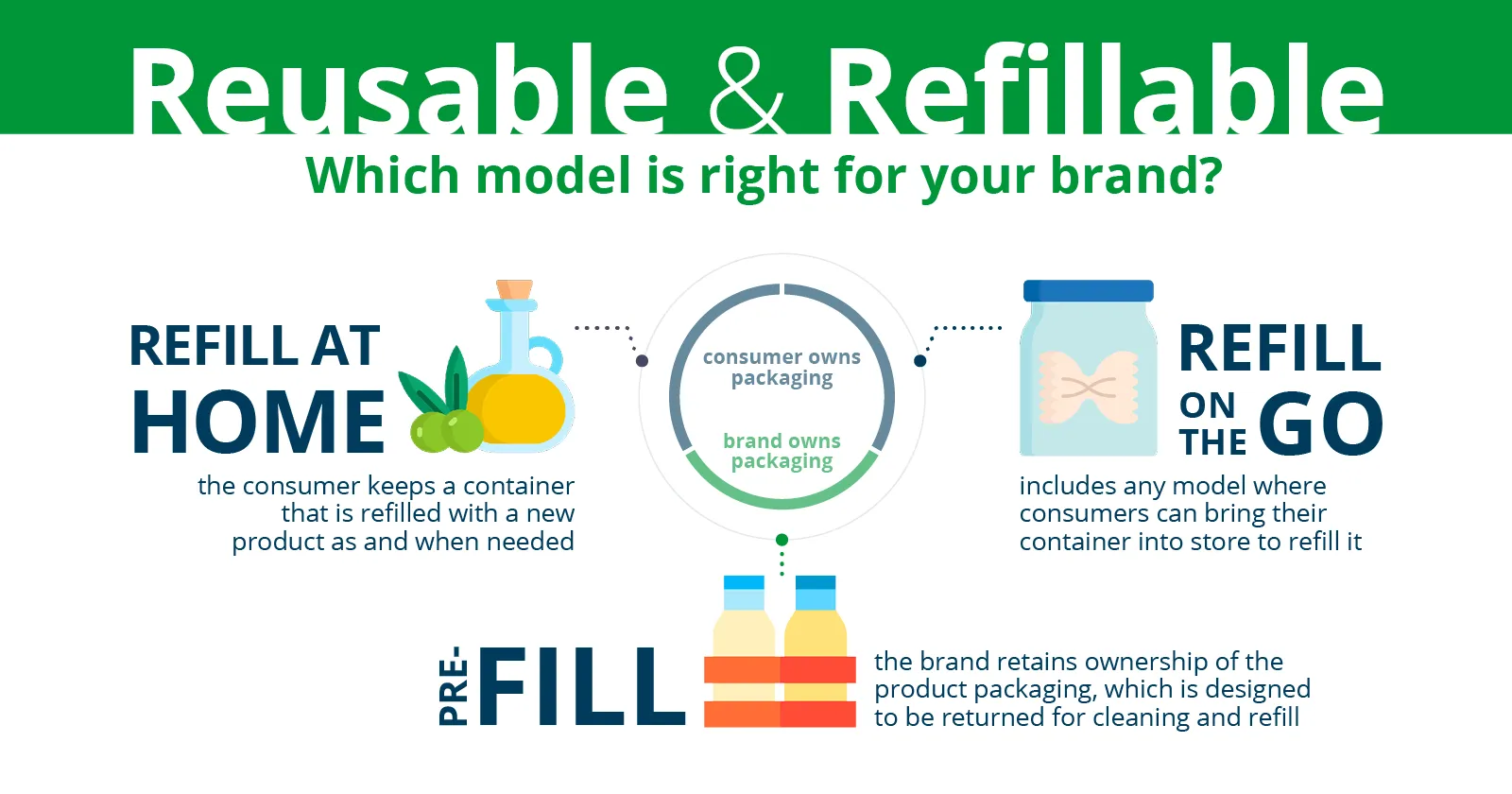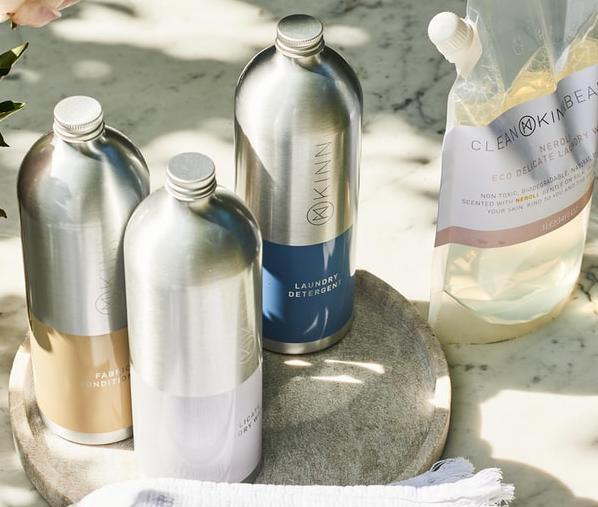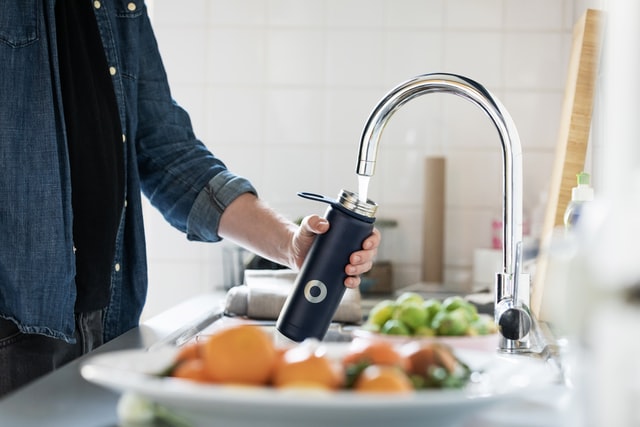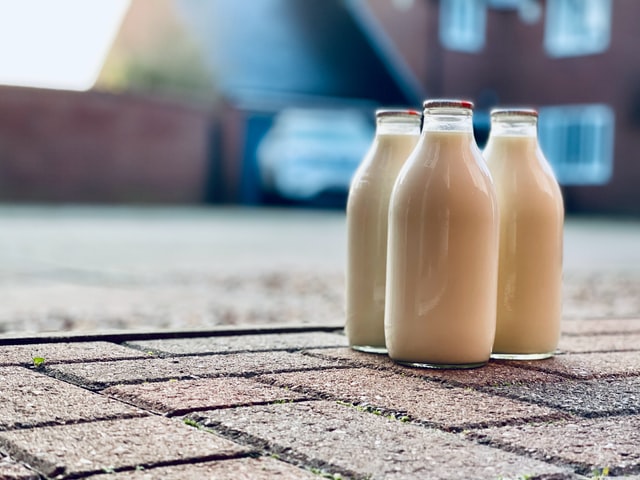The reuse economy is booming, with more and more brands exploring how to adopt reusable and refillable packaging while still bringing consumers the quality and service they expect – in-store, at home, and online.
In our latest blog on sustainable packaging design, we take a closer look at different refill and reuse models and discuss the coding solutions available to help brands meet regulatory demands and inform and connect with consumers at home and on the go.
Spotlight on sustainability
In recent years, governments around the world have emphasised the need to shift towards a circular economy for packaging, with a particular focus on phasing out single-use, virgin, and unrecyclable plastics and exploring options for reusable products and refillable packaging:
- The European Commission’s (EC) Strategy for Plastics in a Circular Economy aims to make all plastic packaging reusable or recyclable by 2030. In addition, in January 2021, the European Union introduced a levy on all non-recycled plastic packaging waste produced by individual members states.
- The UK Government has emphasised its commitment to a circular economy[i]. On 1st April 2022, it introduced a new plastics tax, payable by any company that produces or imports plastic packaging into the UK containing less than 30% recycled content.
- In the US, the Plastics Division of the American Chemistry Council set ambitious goals for capturing, recycling, and recovering plastics, including a commitment to reuse, recycle, or recover 100% of plastic packaging by 2040.
- In September 2021, China’s National Development and Reform Commission and the Ministry of Ecology and Environment introduced a five-year plan to phase out single-use and non-biodegradable plastic bags and packaging.
Many brands have also established ambitious commitments to make their packaging more sustainable by 2025. In addition, more than 500 organisations have signed up to the Ellen MacArthur Foundation’s New Plastics Economy Global Commitment, which recognises that reuse models should be explored to reduce the need for single-use plastic packaging.
Reusable and refillable packaging is also gaining traction at the consumer level. The 2021 Voice of the Consumer: Lifestyles Survey from Euromonitor International revealed that 43% of consumers in Latin America, 44% in North America, 44% in Europe, 40% in Europe, and 32% in the Middle East and Africa identified reusable and refillable packaging as sustainable or better for the environment[ii].
Further research suggests that many consumers would be willing to trial refillable and reusable alternatives: UK consumer interest company Which? found that 75% of UK consumers are open to buying refillable products[iii], while global market intelligence agency Mintel reports that 54% of US food and beverage shoppers are interested in reusable container programmes[iv].
Opportunities for brands exploring refill and reuse models
The Ellen MacArthur Foundation suggests that, globally, replacing just 20% of single-use plastic packaging with reusable alternatives offers an opportunity worth at least USD 10 billion[v].
The benefits extend much further than reducing packaging and transportation costs – reuse and refill models can help to improve the overall consumer experience, build brand loyalty, and generate valuable data and insight to help inform business decisions.
In the following sections, we will explore various consumer-facing reuse and refill models and discuss the different options and opportunities for brands in each area.

Refill-at-home
With a refill-at-home model, the consumer keeps a container that is refilled with a new product as and when needed. Refill-at-home models can work for both online and traditional brick-and-mortar retail – though there are significant benefits for brands operating in the ecommerce space, which we will go into more detail on below.
Refill-at-home is typically suited to the soft beverages and home and personal care sectors. Refill-at-home solutions include bulk buy and standard-size refill pouches, and compact size refills in the form of pods, tablets, and concentrates, which can be diluted with water at home. The packaging used for refill-at-home models is typically designed to be more sustainable than the original packaging – this could mean using lighter or thinner materials, such as flexible pouches in place of rigid plastic containers.
Refill-at-home solutions work particularly well for ecommerce platforms – where they can be offered as part of a handy subscription service, to build brand loyalty and encourage repeat sales. Any consumer that invests in a refillable bottle will be more likely to purchase refills in the future, presenting brands with an opportunity to lock in repeat purchases.
Refill-at-home brands in the ecommerce space are also unrestrained by shelf space in the supermarket and can take the opportunity to provide more options and greater customisation – potentially allowing consumers to mix and match flavours and scents to find their perfect match.
Refill packs will, of course, be subject to the same coding and marking requirements as traditional consumer products – though this may be at a fraction of the size of the original packaging. Brands exploring refill-at-home models could consider utilising 2D codes, such as QR codes, to provide further information to consumers – including instructions on how to refill original packs, as well as personalised reports on how much waste has been eliminated.

Refill-on-the-go
Refill-on-the-go solutions include any model where consumers can bring their container into store to refill it – this includes in-store dispensing platforms and packaging-free ‘buy by weight’ retailers.
Refill-on-the-go models can be used for all manner of fast-moving consumer goods – from food and beverage to home and personal care. The model can accommodate customers’ needs by providing the option to ‘only buy what you need’, helping to avoid product waste. In low-income markets, refill-on-the-go can also reduce the need for single-use sachets.
As with concentrates, refill-on-the-go solutions can help tap into consumers’ desire for greater personalisation – offering a practical option for consumers to ‘pick and mix’ their ideal combination of flavours. In addition, brands can use refill-on-the-go to gather user insight through dispensing systems that recognise the user and collect data on preferences.
Refill-on-the-go solutions may also be subject to coding and marking requirements – for example, allergen labelling for food and beverage products. This requirement can best be achieved using a printed label applied to the packaging after filling. Brands could use these labels to provide an additional touchpoint with consumers after they leave the store or dispenser – for example, with consumer-facing QR codes, for promotions, or loyalty schemes.
Some refill-on-the-go models may necessitate having a consumer buy an initial container which is designed for reuse. Brands that create their own refillable packaging can utilise permanent coding, such as that afforded by laser coders, to create permanent container tracking marks. These can be used to ensure that containers are refilled with the correct products and to deliver premeasured quantities of products, to avoid overfilling which could damage pack integrity or appearance.

Pre-fill
With a pre-fill model, the brand retains ownership of the product packaging, which is designed to be returned for cleaning and refill. Prefill models include traditional retail, also known as ‘return on the go’, and ecommerce solutions or ‘return from home’. In both systems, consumers will typically be charged a refundable deposit to cover the cost of the packaging, which will be returned to the brand for cleaning and refill.
Pre-fill models have long been used in the brewery sector, where glass bottles and kegs are returned and refilled at breweries across Europe and Asia, and in the dairy industry, via traditional milkman delivery services and local supermarkets. Such systems are also common in the domestic energy market – with returnable gas bottles and cylinders. More recently, platforms such as Loop, and Return, Refill, Repeat from Beauty Kitchen, have attempted to bring the pre-fill revolution to brands in more industries.
Pre-fill schemes can allow for the creation of better or more functional, refillable packaging which can provide significant benefits to users and businesses. For example, the stainless steel Häagen-Dazs reusable ice cream container from Loop in the US is double walled so the ice cream inside stays frozen for longer while the outside of the container remains comfortable to touch.
When it comes to coding and marking pre-fill products, there are multiple solutions available for brands looking to meet regulatory requirements, connect with consumers, and gather valuable business insight.
Specific codes, such as best before and use by dates, and batch codes, will need to last the entire shelf life of the packaging and be removed once the product is returned for cleaning and reuse. Potential solutions include stick-on labels, which can be removed once a piece of packaging is returned, or removable inks, such as Domino’s caustic wash inks (2YL855, 2BK118, and 2BK156), which can be removed as part of the final washing process.
Permanent coding solutions – such as those offered by laser coders – also have a role to play here. Permanent, unique, 2D codes can be used to facilitate customer returns, track items throughout their lifecycle, and gather insight on consumer preferences. As the information within 2D codes can be updated, a permanent code could also include batch-specific data, including allergens and use by information, with the details being updated every time the product is refilled. The same codes can also be used as additional touchpoints with customers to build further brand engagement.

Tips for brands exploring reuse and sustainable packaging
- Choose the best model for your business
There is no ‘one size fits all’ solution for sustainable packaging – the ideal solution will vary depending on your sector, products, supply chain capabilities, and standard retail outlets. Identify where you can have the most impact and pick the right model for you.
If you can’t identify a refill and reuse model which suits your business, there are other sustainable packaging solutions to consider, including recycled metal and plastic, and compostable alternatives.
- Make it simple and affordable
Consumers are willing – but they also crave convenience, and the ease of single-use packaging is a huge barrier to widespread refill adoption. Any model needs to be developed with the end consumer in mind to make purchasing, refilling, and returning or recycling as easy as possible. It’s also important to consider pricing and ensure that deposits and initial start-up purchases are competitively priced.
- Use coding and marking to enrich the consumer experience
Consumer-facing variable 2D codes, such as QR codes, can have serious benefits for brands exploring refill and reuse. Consider linking to a brand-specific app to allow your consumers to track purchases, refills, and packaging saved, or provide personalised nutritional information, product suggestions, and loyalty rewards. The same codes can encourage social sharing and reviews or direct users to additional information such as refill and reuse instructions.
Domino is here to help
If you are considering a switch to refillable packaging for your products and would like to speak to someone about the coding and marking solutions available to you, please get in touch.
As an industry leader in coding and marking, we are working to help our customers minimise the risks involved in designing for sustainability and can advise on the best solution to help you meet regulatory demands and provide a unique and personalised experience for your consumers.
Wherever you are in your sustainability journey, Domino is here to help, with experts on hand to advise how best to produce products accepted by retailers, valued by consumers, and trusted by everyone with an environmental concern.
[i] https://www.gov.uk/government/publications/circular-economy-package-policy-statement/circular-economy-package-policy-statement
[ii] https://www.euromonitor.com/article/navigating-sustainable-packaging-in-latin-america
[iii] https://press.which.co.uk/whichpressreleases/manufacturers-and-supermarkets-must-do-more-to-help-consumers-join-refillable-revolution/
[iv] https://www.mintel.com/global-packaging-trends
[v] https://emf.thirdlight.com/link/mtrsnli6m4q0-wm25fb/@/preview/1
Images
Banner image - Photo by Aserusainhuu on Unsplash
Detergent bottles image - Photo by KINN Living on Unsplash
Water bottle image - Photo by Bluewater Sweden on Unsplash
Milk bottle image - Photo by Elizabeth Dunne on Unsplash